Comparative Study of Creep and Stress Relaxation Behaviour during Ageing of 7050 Aluminum Alloy
Abstract
:1. Introduction
2. Experimental Procedures
2.1. Material and Sample Geometry
2.2. Single-Stage Creep and Stress Relaxation Tests
3. Results
3.1. Single-Stage Creep and Stress Relaxation Curves
3.2. Comparison of the Creep Strain Rates between Creep and Stress Relaxation
3.3. Comparison of the Activation Energy between Creep and Stress Relaxation
3.4. Comparison between Single- and Multi-Stage Stress Relaxation Curves
4. Conclusions
- The stress exponent n under the steady state region for creep is 3.7, and stress relaxation is 3.5. The n value for creep tests is constant throughout the tests from primary to steady state creep, indicating that the dislocation slip mechanism is unchanged during the tests. The activation energy evolves with creep time, from 123 kJ/mol to 139 kJ/mol, possibly due to the evolved dislocations. This observation could be a support mechanism for building constitutive equations based on the power-law relationship for the creep and stress relaxation behaviour.
- Similar amount of total creep strains is observed for the single-stage and T74 multi-stage stress relaxation process, i.e., around 19%, 22%, and 30% under an initial stress of 220 MPa, 270 MPa, and 315 MPa. No primary creep region is observed for the multi-stage stress relaxation process at 177 °C. This suggests that for the creep age forming technique of 7050, the material is recommended to be loaded at the start of the second stage to reduce the exposure time of the rigs at high temperatures. The n value at the steady state region for single-stage and multi-stage stress relaxation tests is also the same, i.e., 3.6.
- Higher applied stress promotes the creep and stress relaxation extents. Under the same soaking time, the creep strain at 245 MPa is 3.5 times that at 195 MPa, and the stress relaxation rate at 315 MPa is 1.6 times of that at 220 MPa. The total creep strain achieved from stress relaxation tests is around 2/3 of that from creep tests under identical initial stress levels, if not entering tertiary creep region.
Author Contributions
Funding
Data Availability Statement
Acknowledgments
Conflicts of Interest
References
- Zhan, L.; Lin, J.; Dean, T.A. A review of the development of creep age forming: Experimentation, modelling and applications. Int. J. Mach. Tools Manuf. 2011, 51, 1–17. [Google Scholar] [CrossRef]
- Chen, J.F.; Zhen, L.; Jiang, J.T.; Yang, L.; Shao, W.Z.; Zhang, B.Y. Microstructures and mechanical properties of age-formed 7050 aluminum alloy. Mater. Sci. Eng. A 2012, 539, 115–123. [Google Scholar] [CrossRef]
- Dumont, D.; Deschamps, A.; Brechet, Y. On the relationship between microstructure, strength and toughness in AA7050 aluminum alloy. Mater. Sci. Eng. A 2003, 356, 326–336. [Google Scholar] [CrossRef]
- Pahlavani, M.; Marzbanrad, J.; Rahmatabadi, D.; Hashemi, R.; Bayati, A. A comprehensive study on the effect of heat treatment on the fracture behaviors and structural properties of Mg-Li alloys using RSM. Mater. Res. Express 2019, 6, 076554. [Google Scholar] [CrossRef]
- Lei, C.; Yang, H.; Li, H.; Shi, N.; Zhan, L.H. Dependences of microstructures and properties on initial tempers of creep aged 7050 aluminum alloy. J. Mater. Process. Technol. 2017, 239, 125–132. [Google Scholar] [CrossRef]
- Ho, K.C.; Lin, J.; Dean, T.A. Constitutive modelling of primary creep for age forming an aluminum alloy. J. Mater. Process. Technol. 2004, 153–154, 122–127. [Google Scholar] [CrossRef]
- Lin, J.; Ho, K.C.; Dean, T.A. An integrated process for modelling of precipitation hardening and springback in creep age-forming. Int. J. Mach. Tools Manuf. 2006, 46, 1266–1270. [Google Scholar] [CrossRef]
- Zheng, J.-H.; Davies, C.M.; Lin, J.; Pan, R.; Li, C. Constitutive modelling of a T74 multi-step creep ageing behaviour of AA7050 and its application to stress relaxation ageing in age formed aluminum components. Procedia Eng. 2017, 207, 281–286. [Google Scholar] [CrossRef]
- Li, Y.; Shi, Z.; Lin, J.; Yang, Y.L.; Huang, B.M.; Chung, T.F.; Yang, J.R. Experimental investigation of tension and compression creep-ageing behaviour of AA2050 with different initial tempers. Mater. Sci. Eng. A 2016, 657, 299–308. [Google Scholar] [CrossRef]
- Rahmatabadi, D.; Tayyebi, M.; Najafizadeh, N.; Hashemi, R.; Rajabi, M. The influence of post-annealing and ultrasonic vibration on the formability of multilayered Al5052/MgAZ31B composite. Mater. Sci. Technol. 2021, 37, 78–85. [Google Scholar] [CrossRef]
- Wang, K.; Zhan, L.-h.; Yang, Y.-l.; Ma, Z.-y.; Li, X.-c.; Liu, J. Constitutive modeling and springback prediction of stress relaxation age forming of pre-deformed 2219 aluminum alloy. Trans. Nonferrous Met. Soc. China 2019, 29, 1152–1160. [Google Scholar] [CrossRef]
- Guo, J.Q.; Tian, L.; Shi, H.C.; Meng, W.Z. Using Stress Relaxation Data to Predict Creep Behavior. Adv. Mater. Res. 2013, 842, 382–385. [Google Scholar] [CrossRef]
- Zhan, L.H.; Li, Y.G.; Huang, M.H.; Lin, J.G. Comparative Study of Creep and Stress Relaxation Behavior for 7055 Aluminum Alloy. Adv. Mater. Res. 2011, 314–316, 772–777. [Google Scholar] [CrossRef]
- Lihua, S.; Ling, Y. Research on conversion relationship between aging creep and aging stress relaxation. J. Plast. Eng. 2012, 20, 126–131. [Google Scholar] [CrossRef]
- Li, Y.; Shi, Z. A New Method to Characterize and Model Stress-Relaxation Aging Behavior of Aluminum Alloys Under Age Forming Conditions. Metall. Mater. Trans. A 2022, 53, 1345–1360. [Google Scholar] [CrossRef]
- Lyu, F.; Li, Y.; Shi, Z.; Huang, X.; Zeng, Y.; Lin, J. Stress and temperature dependence of stress relaxation ageing behaviour of an Al–Zn–Mg alloy. Mater. Sci. Eng. A 2020, 773, 138859. [Google Scholar] [CrossRef]
- Li, Y.; Lyu, F.; Shi, Z.; Zeng, Y.; Huang, X.; Lin, J. Experimental Study and Modelling of Stress Relaxation Ageing Behaviour and Post-form Mechanical Properties in Creep Age Forming of Al-Zn-Mg Alloy. In Forming the Future; Springer International Publishing: Cham, Switzerland, 2021; pp. 877–889. [Google Scholar] [CrossRef]
- Zheng, J.; Davies, C.M.; Lin, J. Comparison of creep deformation rates during load and strain controlled multi-step creep ageing tests on AA7050. In Proceedings of the 2017 of Conference, Pulau Pinang, Malaysia, 8–9 August 2017. [Google Scholar] [CrossRef]
- Xu, Y.; Zhan, L.; Li, W. Effect of pre-strain on creep aging behavior of 2524 aluminum alloy. J. Alloys Compd. 2017, 691, 564–571. [Google Scholar] [CrossRef]
- Zhan, L.; Ma, Z.; Zhang, J.; Tan, J.; Yang, Z.; Li, H. Stress relaxation ageing behaviour and constitutive modelling of a 2219 aluminum alloy under the effect of an electric pulse. J. Alloys Compd. 2016, 679, 316–323. [Google Scholar] [CrossRef]
- El-Danaf, E.A.; Baig, M. High temperature deformation characteristics of equal channel angular pressed AA6082-T6. Mater. Sci. Eng. A 2013, 565, 301–307. [Google Scholar] [CrossRef]
- Zhao, T.-S.; Zhou, J.; Zhou, J.-F.; Wu, D.-X.; Xiong, Y. Influence of pre-stretching and aging processes on comprehensive performance of aluminum alloy. Mater. Manuf. Process. 2018, 33, 1641–1647. [Google Scholar] [CrossRef]
- Guo, W.; Guo, J.; Wang, J.; Yang, M.; Li, H.; Wen, X.; Zhang, J. Evolution of precipitate microstructure during stress aging of an Al–Zn–Mg–Cu alloy. Mater. Sci. Eng. A 2015, 634, 167–175. [Google Scholar] [CrossRef]
- Yang, Y.; Zhan, L.; Liu, C.; Wang, X.; Wang, Q.; Tang, Z.; Li, G.; Huang, M.; Hu, Z. Stress-relaxation ageing behavior and microstructural evolution under varying initial stresses in an Al–Cu alloy: Experiments and modeling. Int. J. Plast. 2020, 127, 102646. [Google Scholar] [CrossRef]
- Chen, J.F.; Jiang, J.T.; Zhen, L.; Shao, W.Z. Stress relaxation behavior of an Al–Zn–Mg–Cu alloy in simulated age-forming process. J. Mater. Process. Technol. 2014, 214, 775–783. [Google Scholar] [CrossRef]
- Wang, Z.; Tian, R.Z. Manual of Aluminum and Its Processing, 3rd ed.; Central South University Press: Changsha, China, 2005. [Google Scholar]
- Zhan, L.; Lin, J.; Dean, T.A.; Huang, M. Experimental studies and constitutive modelling of the hardening of aluminum alloy 7055 under creep age forming conditions. Int. J. Mech. Sci. 2011, 53, 595–605. [Google Scholar] [CrossRef]
- Chen, X.; Zhan, L.; Ma, Z.; Xu, Y.; Zheng, Q.; Cai, Y. Study on tensile/compressive asymmetry in creep ageing behavior of Al–Cu alloy under different stress levels. J. Alloys Compd. 2020, 843, 156157. [Google Scholar] [CrossRef]
- Rong, Q.; Li, Y.; Shi, Z.; Meng, L.; Sun, X.; Sun, X.; Lin, J. Experimental investigations of stress-relaxation ageing behaviour of AA6082. Mater. Sci. Eng. A 2019, 750, 108–116. [Google Scholar] [CrossRef]
- Zhang, J.; Deng, Y.; Zhang, X. Constitutive modeling for creep age forming of heat-treatable strengthening aluminum alloys containing plate or rod shaped precipitates. Mater. Sci. Eng. A 2013, 563, 8–15. [Google Scholar] [CrossRef]
- Zuo, D.; Cao, Z.; Cao, Y.; Zheng, G. Effect of pre-stretching on microstructures and mechanical behaviors of creep-aged 7055 Al alloy and its constitutive modeling. Metals 2019, 9, 584. [Google Scholar] [CrossRef]
- Ashby, M.F. A first report on deformation-mechanism maps. Acta Metall. 1972, 20, 887–897. [Google Scholar] [CrossRef]
- Ashby, M.F. Boundary defects, and atomistic aspects of boundary sliding and diffusional creep. Surf. Sci. 1972, 31, 498–542. [Google Scholar] [CrossRef]
- Liu, C.; Yang, J.; Ma, P.; Ma, Z.; Zhan, L.; Chen, K.; Huang, M.; Li, J.; Li, Z. Large creep formability and strength–ductility synergy enabled by engineering dislocations in aluminum alloys. Int. J. Plast. 2020, 134, 102774. [Google Scholar] [CrossRef]
- Kassner, M.E. Fundamentals of Creep in Metals and Alloys; Butterworth-Heinemann: Oxford, UK, 2015. [Google Scholar]
- Shi, C.; Mao, W.; Chen, X.G. Evolution of activation energy during hot deformation of AA7150 aluminum alloy. Mater. Sci. Eng. A 2013, 571, 83–91. [Google Scholar] [CrossRef]
- Mott, N.F.; Nabarro, F. Dislocation Theory and Transient Creep. 1948. Available online: https://wiredspace.wits.ac.za/handle/10539/1195 (accessed on 31 August 2006).
- Sherby, O.D.; Lytton, J.L.; Dorn, J.E. Activation energies for creep of high-purity aluminum. Acta Metall. 1957, 5, 219–227. [Google Scholar] [CrossRef]
- Robey, R.; Prangnell, P.; Dif, R. A Comparison of the Stress Relaxation Behavior of Three Aluminum Aerospace Alloys for use in Age-Forming Applications. In Materials Forum; Institute of Materials Engineering Australasia Ltd.: Brisbane, Australia, 2004; pp. 132–138. [Google Scholar]
- Zheng, J.-H.; Pan, R.; Li, C.; Zhang, W.; Lin, J.; Davies, C.M. Experimental investigation of multi-step stress-relaxation-ageing of 7050 aluminum alloy for different pre-strained conditions. Mater. Sci. Eng. A 2018, 710, 111–120. [Google Scholar] [CrossRef]
- Evangelista, E.; Spigarelli, S.J.M.; A, m.t. Constitutive equations for creep and plasticity of aluminum alloys produced by powder metallurgy and aluminum-based metal matrix composites. Metall. Mater. Trans. A 2002, 33, 373–381. [Google Scholar] [CrossRef]
- Somekawa, H.; Hirai, K.; Watanabe, H.; Takigawa, Y.; Higashi, K. Dislocation creep behavior in Mg–Al–Zn alloys. Mater. Sci. Eng. A 2005, 407, 53–61. [Google Scholar] [CrossRef]

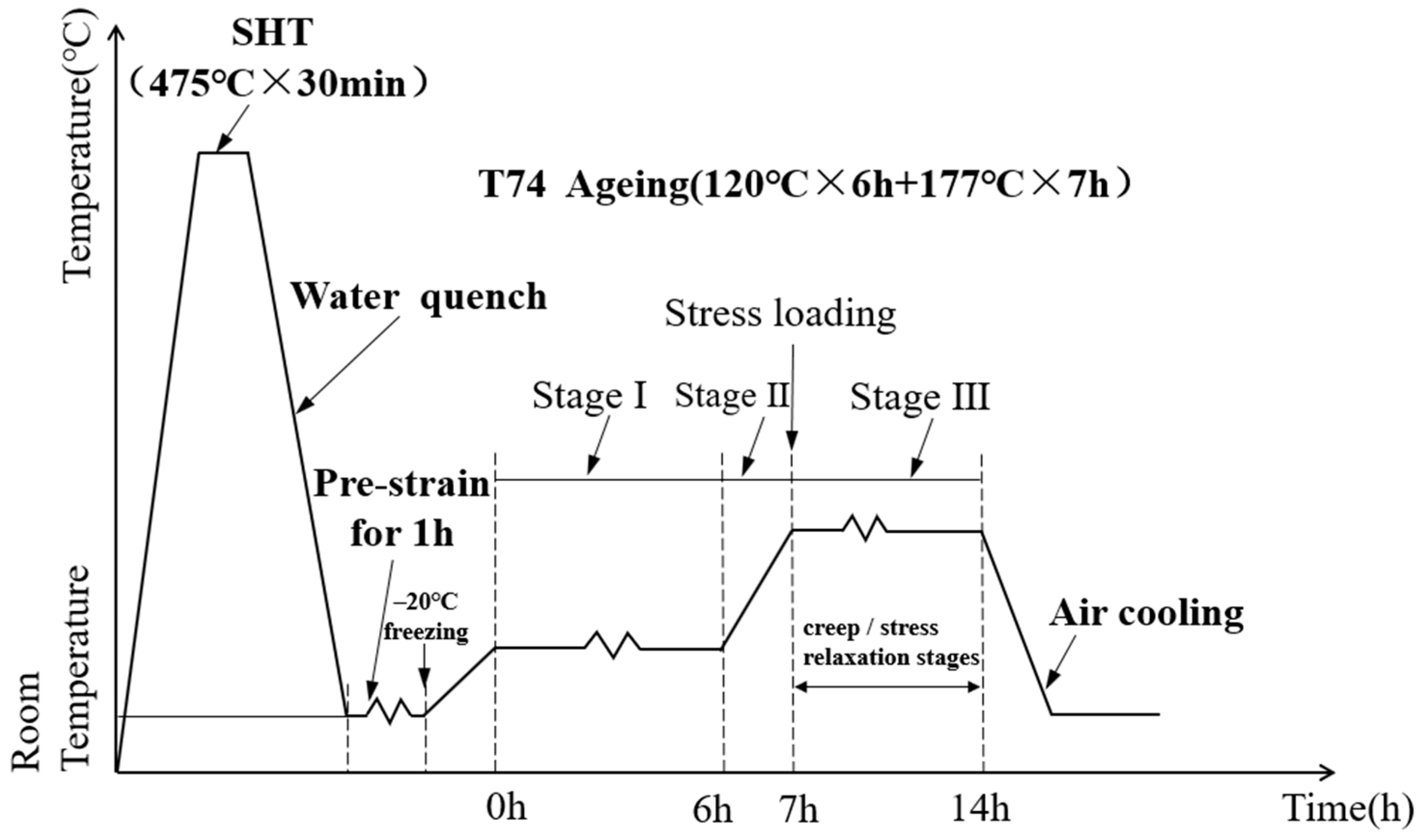
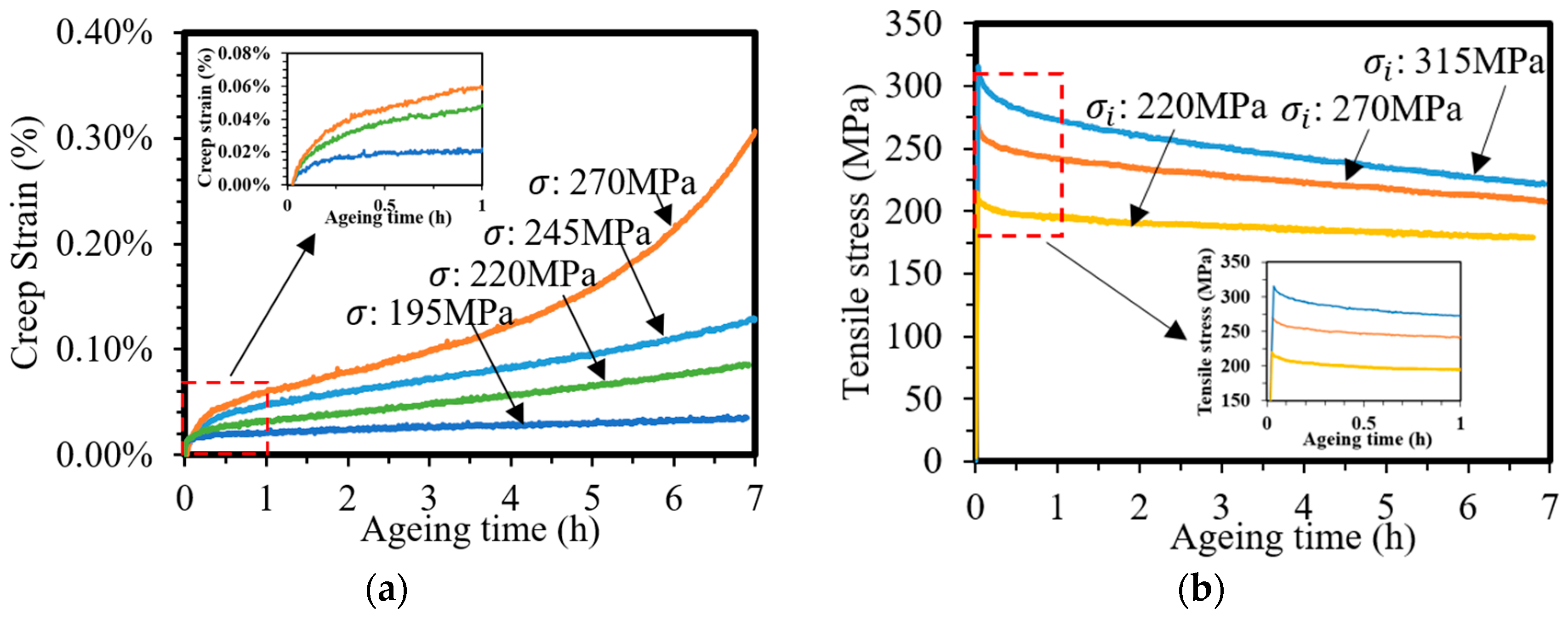

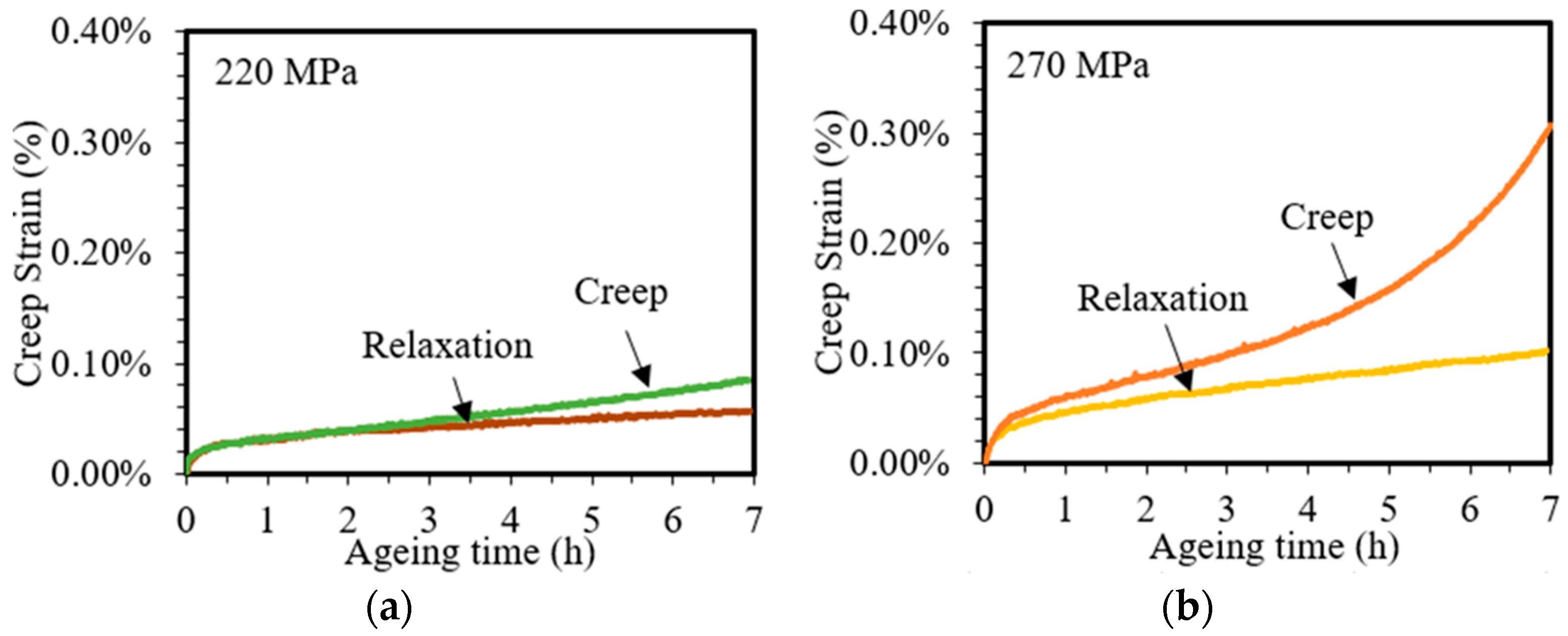
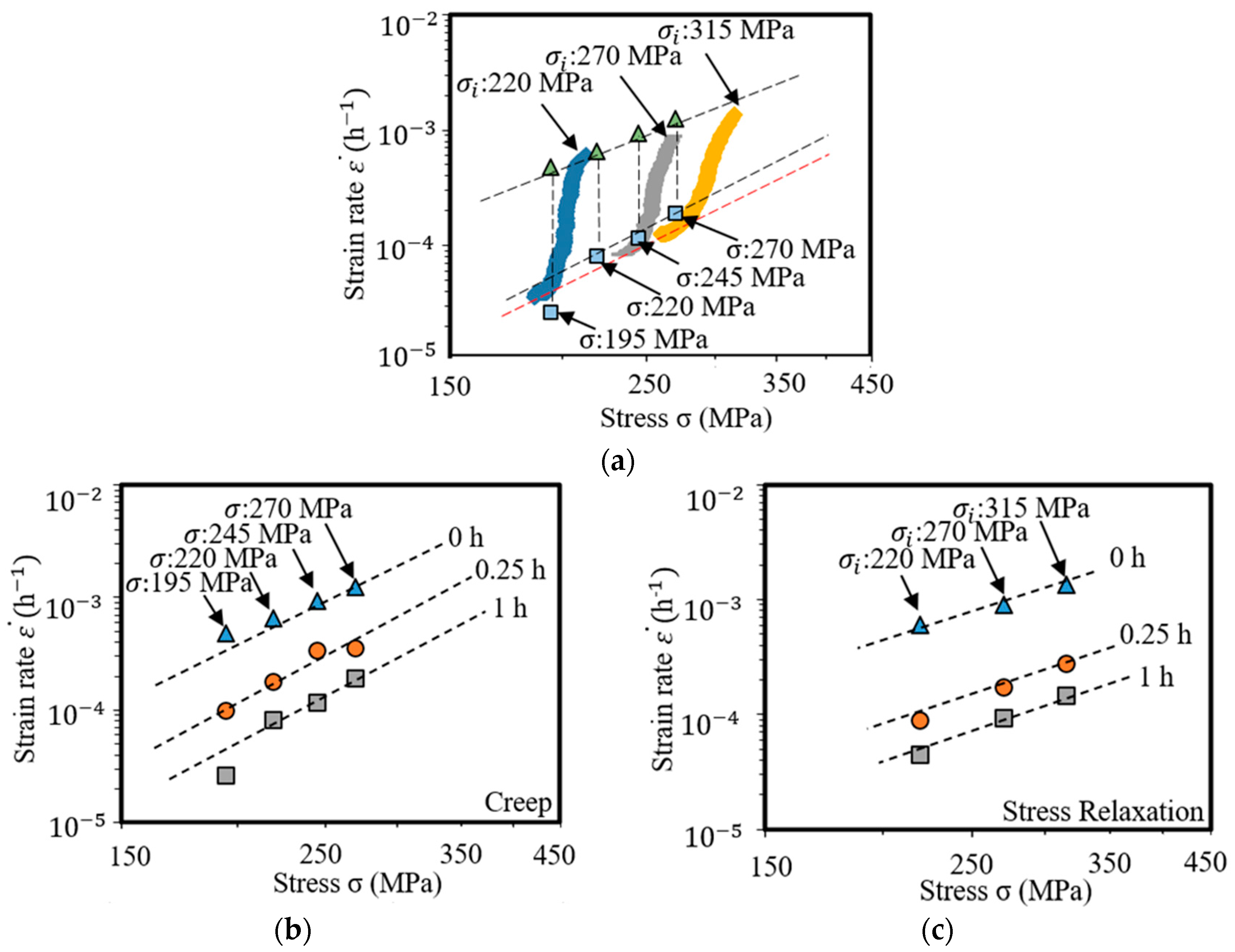
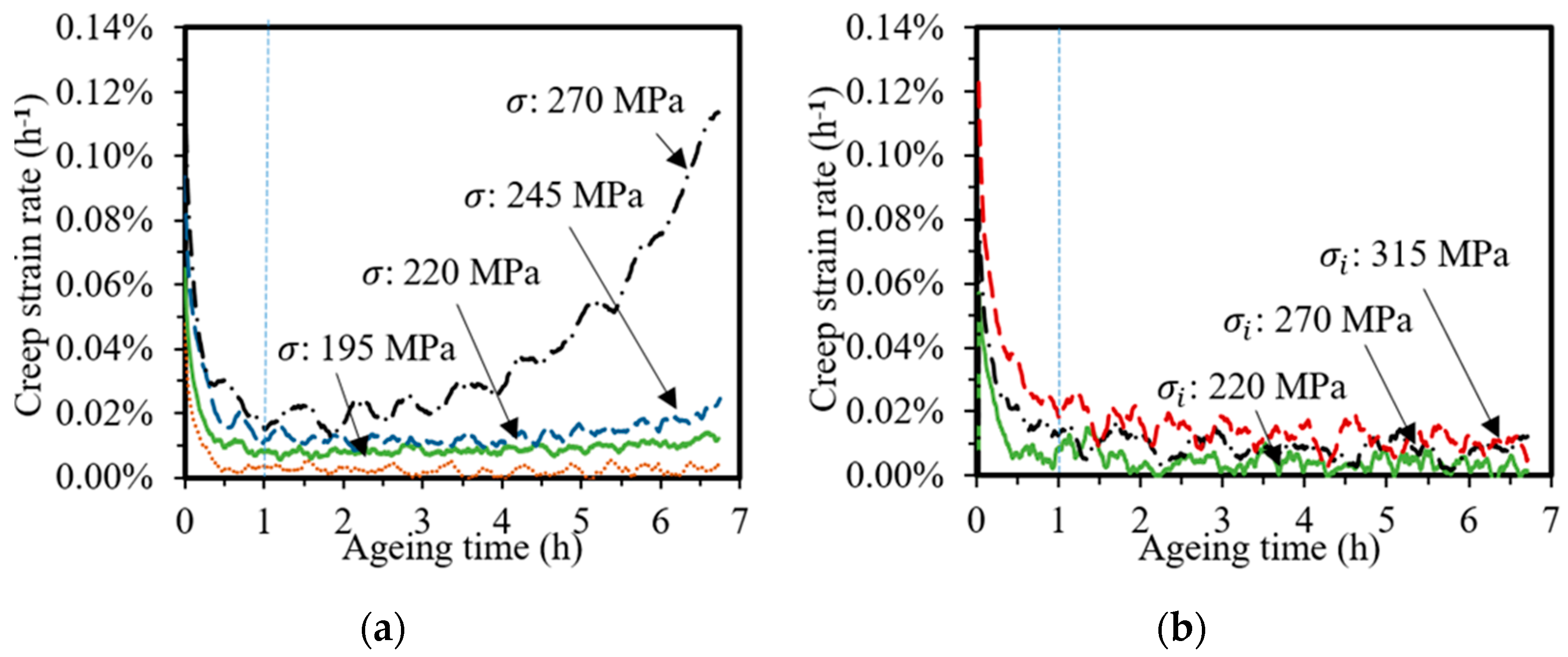
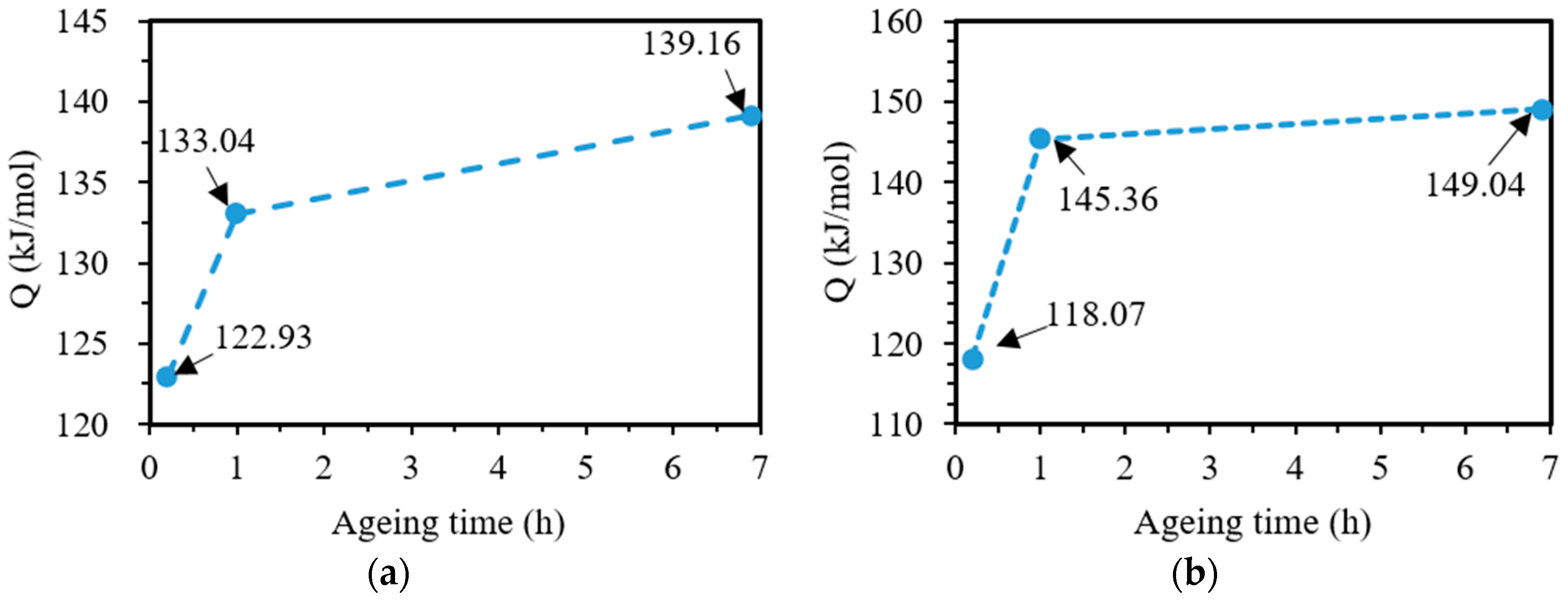
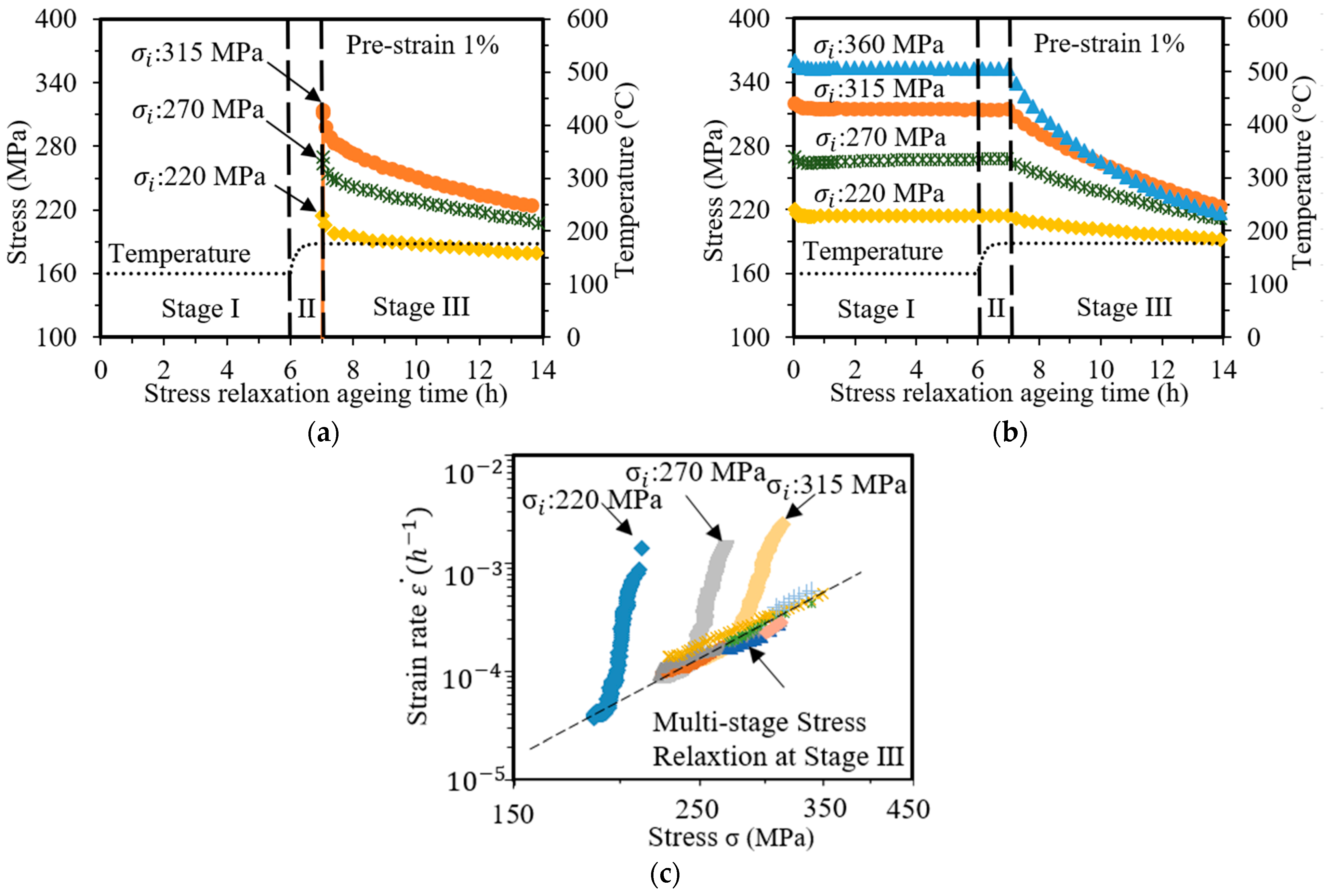
| Al | Zn | Mg | Cu |
|---|---|---|---|
| Bal. | 5.7–6.7 | 1.9–2.6 | 2–2.6 |
| Experiment | Testing Conditions | Initial Creep Rate (h−1) | 0.25 h Creep Rate (h−1) | Steady State Creep Rate (h−1) |
|---|---|---|---|---|
| Creep | 195 MPa/177 °C × 7 h | 4.77 × 10−4 | 9.96 × 10−5 | 2.62 × 10−5 |
| 220 MPa /177 °C × 7 h | 6.50 × 10−4 | 1.77 × 10−4 | 8.15 × 10−5 | |
| 245 MPa /177 °C × 7 h | 9.37 × 10−4 | 3.40 × 10−4 | 1.17 × 10−4 | |
| 270 MPa /177 °C × 7 h | 1.25 × 10−3 | 3.53 × 10−4 | 1.90 × 10−4 | |
| Stress relaxation | 220 MPa /177 °C × 7 h | 6.09 × 10−4 | 8.79 × 10−5 | 4.52 × 10−5 |
| 270 MPa /177 °C × 7 h | 8.93 × 10−4 | 1.73 × 10−4 | 0.93 × 10−4 | |
| 315 MPa /177 °C × 7 h | 1.35 × 10−3 | 2.79 × 10−4 | 1.46 × 10−4 |
Disclaimer/Publisher’s Note: The statements, opinions and data contained in all publications are solely those of the individual author(s) and contributor(s) and not of MDPI and/or the editor(s). MDPI and/or the editor(s) disclaim responsibility for any injury to people or property resulting from any ideas, methods, instructions or products referred to in the content. |
© 2023 by the authors. Licensee MDPI, Basel, Switzerland. This article is an open access article distributed under the terms and conditions of the Creative Commons Attribution (CC BY) license (https://creativecommons.org/licenses/by/4.0/).
Share and Cite
Zheng, J.-H.; Jin, Y.; Xu, L.; Fan, C.; Song, W.; Chen, Y. Comparative Study of Creep and Stress Relaxation Behaviour during Ageing of 7050 Aluminum Alloy. Metals 2023, 13, 778. https://doi.org/10.3390/met13040778
Zheng J-H, Jin Y, Xu L, Fan C, Song W, Chen Y. Comparative Study of Creep and Stress Relaxation Behaviour during Ageing of 7050 Aluminum Alloy. Metals. 2023; 13(4):778. https://doi.org/10.3390/met13040778
Chicago/Turabian StyleZheng, Jing-Hua, Yufeng Jin, Lang Xu, Congze Fan, Wenzhe Song, and Yiwei Chen. 2023. "Comparative Study of Creep and Stress Relaxation Behaviour during Ageing of 7050 Aluminum Alloy" Metals 13, no. 4: 778. https://doi.org/10.3390/met13040778
APA StyleZheng, J.-H., Jin, Y., Xu, L., Fan, C., Song, W., & Chen, Y. (2023). Comparative Study of Creep and Stress Relaxation Behaviour during Ageing of 7050 Aluminum Alloy. Metals, 13(4), 778. https://doi.org/10.3390/met13040778





